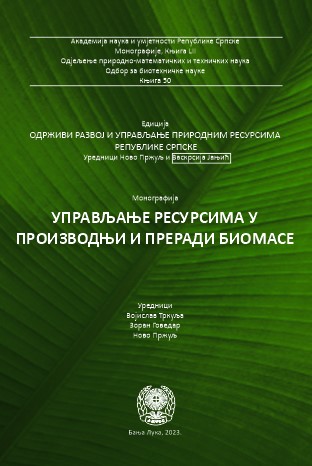Historical overview and current status of the production and use of biomass
DOI:
https://doi.org/10.7251/EORU2306065DJKeywords:
Biomass, pyrolysis, gasification, combustionAbstract
It is known that the combustion of fossil fuels is the main artificial source of CO2 emissions into the atmosphere and that it leads to environmental pollution, as well as global climate changes, i.e. the “greenhouse” effect. For these reasons, instead of fossil fuels used in various branches of energy and process technology, we shouldswitch to alternative energy sources that would significantly reduce the emission of CO2 and other greenhouse gases. Biomass is plant material obtained by the reaction of carbon dioxide from air, water and sunlight, the process of photosynthesis, in order to produce carbohydrates. In adecayprocess of organic matter from plant residues, carbon is returned to the atmosphere in a form of carbon dioxide and/or methane. In the atmosphere, during the oxidation process, carbon dioxide is formed from methane again, which completes the carbon cycle in nature. Today, biofuel is the only fuel that meets the criteria of a closed system in terms of the creation of carbon dioxide and solid material combustion products. Most of the carbon released in a form of carbon dioxide is absorbed by the next generation of plants through photosynthesis or through minerals from the soil. Thus, biomass is becoming one of the key energy resources in the fight against global warming and depletion of fossil fuel reserves. Additionally, replacing fossil fuels with biomass has a beneficial impact on reducing the emission of sulfur dioxide, which causesacid rainformation. It should be noted that the primary advantage of biomass as an energy source is not in its significant potential, but in its renewability. Renewability is the essential advantage of biomass over conventional, fossil fuels that are nonrenewable and therefore cannot be the basis for long-term planning of sustainable growth that implies the rational use of energy. In the field of energetics, the European Union (EU) is aimed at reducing CO2 emissions in order to achieve sustainable development, as well as reducing dependence on imported fuels and changes in pricesof energy-generating products (oil, gas, etc.). One way to reduce CO2 emissions is to increase the share of renewable sources in total energy production. The goal of the EU countries is to achieve 20% energy savings, 20% production of energy from renewable sources, 20% reduction of CO2 emissions ("20-20-20-targets") (Directive 2009/28/EC). In order to maintain energy stability and approach closer to the EU, Bosnia and Herzegovina, as well as the Republic ofSrpska, have signed a number of laws and regulations on the use of renewable energy sources. This paper provides review data on biomass potentials (wood and agricultural) in Bosnia and Herzegovina and in the neighbouring countries. Special emphasis is on agricultural biomass. Data on physical and chemical properties of agricultural biomass as an energy fuel are presented. Thermochemical procedures of biomass processing are provided, such as: pyrolysis, gasification and combustion and the possibility of using energy from these processes. Apparatus and furnaces of the considered processes used in industrial practice are presented. An overview of pollutant emissions from the biomass combustion process is also given.
